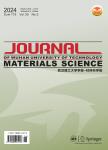Model of Diffusion of Sulfur in Soda-lime-silicate Glass:An Experimental and Comparative Study
Model of Diffusion of Sulfur in Soda-lime-silicate Glass:An Experimental and Comparative Study作者机构:State Key Laboratory of Green Building MaterialsChina Building Materials AcademyBeijing 100024China Institute of GlassResearchChina Building Materials AcademyBeijing 100024China Materials and Chemical EngineeringHainan UniversityHaikou 570228China
出 版 物:《Journal of Wuhan University of Technology(Materials Science)》 (武汉理工大学学报(材料科学英文版))
年 卷 期:2017年第32卷第1期
页 面:76-79页
核心收录:
学科分类:08[工学] 0805[工学-材料科学与工程(可授工学、理学学位)] 080502[工学-材料学]
基 金:Funded by National Natural Science Foundation of China(NSFC)(No.50972136) National Science and Technology S upporting P rogram(No.2015BAA02B00) National Key Technologies R&D Program(No.2016YFB0303900) the Fundamental Research Funds of State Key Laboratory for Advanced Technology of Float Glass
主 题:diffusion sulfur soda-lime-silicate glass secondary ion mass spectroscopy
摘 要:The diffusion property of sulfur on the soda-lime-silicate float glass surface was studied by using secondary ion mass spectroscopy(SIMS).According to the Fick's Second Law,two models of diffusion of sulfur on the glass surface were *** the diffusion of sulfate(S^6+) is considered uniquely,the concentration-depth profile of sulfur can not be fitted very well,especially on the top surfaces of the air side and tin side of float *** the diffusion of sulfide(S^2-) on the profile of sulfur can not be *** concentration-depth profile of sulfur on both sides of glass can be fitted more exactly when both S^6+ and S^2- are *** on the above-mentioned fitting results,it is concluded that the diffusion coefficents of S^6+ and S^2- of tin side are larger than those of the air ***,the diffusion coefficents are related to the contacted medium.



